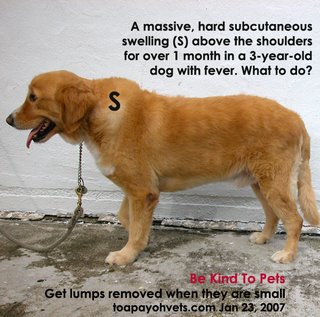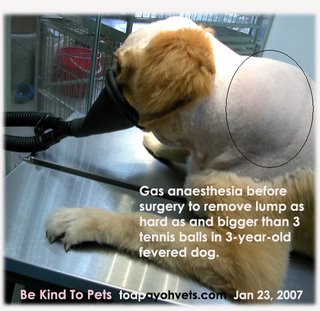A risky canine surgery
Seldom will you find a dog "crying" under deep general anesthesia. This Golden Retriever Cross just could not stop whinining continuously on the operating table. "Her...her...her..." non-stop. Was he having a nightmare or in great pain? Would
his heart stop beating when he stopped whining? Should I have waited for 10 days before operating?
He was not an ideal candidate for surgery as he had steroids which reduced his immune system for over 4 weeks. Now he had fever as well. The hard as 3 tennis balls' lump under his skin. The steroids and antibiotics for over a month from a veterinarian had not reduced the size of the subcutaneous lump. Red blood was drawn out from the lump. So, was it a haematoma or a form of fat cell tumour? How did it arise? Nobody knew. What to do with it now? The dog had antibiotics for so many weeks but now had a fever. Was it an infectious fever or the toxins of the lump causing fever?
I suspected it was toxins. So, it would be better to operate and remove the lump. Waiting for another ten days would not be good for this dog. But he was not the ideal candidate for surgery as he had fever.
A very hard decision. If the dog survived, everybody would be happy. The risks were higher than usual.
Back to this whining on the operating table. It was very rare for any deeply anaesthesized dog to make any noise. I cut a big 15-cm curved incision above his right shoulder. As short as possible. The dog did not feel the pain.
Yet he was whining away. More like crying for help. Lots of white hard lumps of cells and blood clotted tissues were taken out with my hands. Lots of bleeding. I estimated at least 1 litre of blood lost. But there was no turning back. I rather not do this type of surgery as the outcome is unpredictable.
The subcutaneous fat under the skin was 3 cm normal white oily cells. The connective tissues below were all red and black, hard clumps here and there. I felt with my fingers the left shoulder area to remove all. I did not want to make a bigger cut.

I removed most of the abnormal tissues. I could feel the spine of the right scapula (shoulder blade). Blood seeped out continuously. A large mass of blood vessels seemed to be stuck to the tissues was removed. More bleeding. Slow bleeding.
Would this dog die from haemorrhage?
An intravenous drip was given. The dog could not stand up for 24 hours after surgery unlike other dogs. On the 3rd day he went home. He slept a lot. On the 5th day after surgery, he could eat.
Wound maintenance at home was important. He had a good owner who had medical training --- in human teeth. He was very well cared for. So far on this day 5, he was starting to eat and scratching his wound. So far, so good.


Such challenging surgeries in dogs with a long period of steroids and fever are best not done as outcome is very unpredictable. Steroids lowered his immune system considerably. Antibiotics over a long period of time might or might not have been effective. The owner had stopped the medication. So, was this dog having a bacterial infection or toxaemia?
The vet has to make an instant judgment in the interest of the dog. Could the dog get worse if the surgery was delayed further? The owner had to be informed of the risk and understand. In this case, an antibiotic injection was given 12 hours before the surgery. It was unlikely that this dog could wait another 7 - 10 days for surgery as he was not eating much and had vomited earlier.
Normally, I don't perform such surgeries till the dog's conditions are stable and ideal. There are always exceptions to the norm.
his heart stop beating when he stopped whining? Should I have waited for 10 days before operating?
He was not an ideal candidate for surgery as he had steroids which reduced his immune system for over 4 weeks. Now he had fever as well. The hard as 3 tennis balls' lump under his skin. The steroids and antibiotics for over a month from a veterinarian had not reduced the size of the subcutaneous lump. Red blood was drawn out from the lump. So, was it a haematoma or a form of fat cell tumour? How did it arise? Nobody knew. What to do with it now? The dog had antibiotics for so many weeks but now had a fever. Was it an infectious fever or the toxins of the lump causing fever?
I suspected it was toxins. So, it would be better to operate and remove the lump. Waiting for another ten days would not be good for this dog. But he was not the ideal candidate for surgery as he had fever.
A very hard decision. If the dog survived, everybody would be happy. The risks were higher than usual.
Back to this whining on the operating table. It was very rare for any deeply anaesthesized dog to make any noise. I cut a big 15-cm curved incision above his right shoulder. As short as possible. The dog did not feel the pain.
Yet he was whining away. More like crying for help. Lots of white hard lumps of cells and blood clotted tissues were taken out with my hands. Lots of bleeding. I estimated at least 1 litre of blood lost. But there was no turning back. I rather not do this type of surgery as the outcome is unpredictable.
The subcutaneous fat under the skin was 3 cm normal white oily cells. The connective tissues below were all red and black, hard clumps here and there. I felt with my fingers the left shoulder area to remove all. I did not want to make a bigger cut.

I removed most of the abnormal tissues. I could feel the spine of the right scapula (shoulder blade). Blood seeped out continuously. A large mass of blood vessels seemed to be stuck to the tissues was removed. More bleeding. Slow bleeding.
Would this dog die from haemorrhage?
An intravenous drip was given. The dog could not stand up for 24 hours after surgery unlike other dogs. On the 3rd day he went home. He slept a lot. On the 5th day after surgery, he could eat.
Wound maintenance at home was important. He had a good owner who had medical training --- in human teeth. He was very well cared for. So far on this day 5, he was starting to eat and scratching his wound. So far, so good.


Such challenging surgeries in dogs with a long period of steroids and fever are best not done as outcome is very unpredictable. Steroids lowered his immune system considerably. Antibiotics over a long period of time might or might not have been effective. The owner had stopped the medication. So, was this dog having a bacterial infection or toxaemia?
The vet has to make an instant judgment in the interest of the dog. Could the dog get worse if the surgery was delayed further? The owner had to be informed of the risk and understand. In this case, an antibiotic injection was given 12 hours before the surgery. It was unlikely that this dog could wait another 7 - 10 days for surgery as he was not eating much and had vomited earlier.
Normally, I don't perform such surgeries till the dog's conditions are stable and ideal. There are always exceptions to the norm.


0 Comments:
Post a Comment
<< Home